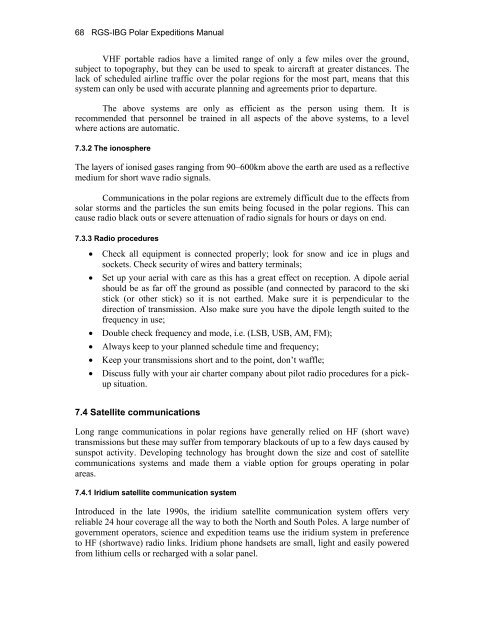Edited by Rachel Duncan 4th Edition ISBN 0-907649-91-2 London ...
Edited by Rachel Duncan 4th Edition ISBN 0-907649-91-2 London ...
Edited by Rachel Duncan 4th Edition ISBN 0-907649-91-2 London ...
Create successful ePaper yourself
Turn your PDF publications into a flip-book with our unique Google optimized e-Paper software.
68 RGS-IBG Polar Expeditions Manual<br />
VHF portable radios have a limited range of only a few miles over the ground,<br />
subject to topography, but they can be used to speak to aircraft at greater distances. The<br />
lack of scheduled airline traffic over the polar regions for the most part, means that this<br />
system can only be used with accurate planning and agreements prior to departure.<br />
The above systems are only as efficient as the person using them. It is<br />
recommended that personnel be trained in all aspects of the above systems, to a level<br />
where actions are automatic.<br />
7.3.2 The ionosphere<br />
The layers of ionised gases ranging from 90–600km above the earth are used as a reflective<br />
medium for short wave radio signals.<br />
Communications in the polar regions are extremely difficult due to the effects from<br />
solar storms and the particles the sun emits being focused in the polar regions. This can<br />
cause radio black outs or severe attenuation of radio signals for hours or days on end.<br />
7.3.3 Radio procedures<br />
• Check all equipment is connected properly; look for snow and ice in plugs and<br />
sockets. Check security of wires and battery terminals;<br />
• Set up your aerial with care as this has a great effect on reception. A dipole aerial<br />
should be as far off the ground as possible (and connected <strong>by</strong> paracord to the ski<br />
stick (or other stick) so it is not earthed. Make sure it is perpendicular to the<br />
direction of transmission. Also make sure you have the dipole length suited to the<br />
frequency in use;<br />
• Double check frequency and mode, i.e. (LSB, USB, AM, FM);<br />
• Always keep to your planned schedule time and frequency;<br />
• Keep your transmissions short and to the point, don’t waffle;<br />
• Discuss fully with your air charter company about pilot radio procedures for a pickup<br />
situation.<br />
7.4 Satellite communications<br />
Long range communications in polar regions have generally relied on HF (short wave)<br />
transmissions but these may suffer from temporary blackouts of up to a few days caused <strong>by</strong><br />
sunspot activity. Developing technology has brought down the size and cost of satellite<br />
communications systems and made them a viable option for groups operating in polar<br />
areas.<br />
7.4.1 Iridium satellite communication system<br />
Introduced in the late 1990s, the iridium satellite communication system offers very<br />
reliable 24 hour coverage all the way to both the North and South Poles. A large number of<br />
government operators, science and expedition teams use the iridium system in preference<br />
to HF (shortwave) radio links. Iridium phone handsets are small, light and easily powered<br />
from lithium cells or recharged with a solar panel.

















